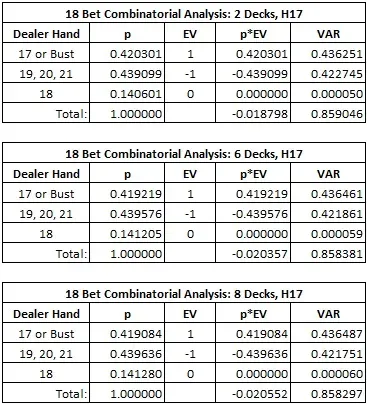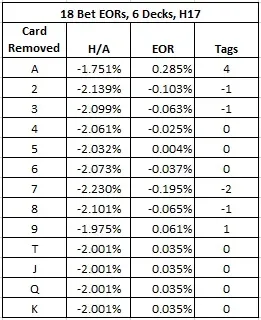The winner of the “Best New Table Game” prize at this year’s Cutting Edge Table Games Conference was Pick ‘Em Blackjack. This side bet consists of three wagers the player can make in addition to his ordinary blackjack wager. These wagers are:
- The “17 Bet.” This wager wins if the dealer busts, is a push if the dealer gets a total of 17, otherwise the player loses. A winning wager is paid 3-to-2.
- The “18 Bet.” This wager wins if the dealer busts or has a final total of 17, is a push if the dealer gets a total of 18, otherwise the player loses. A winning wager is paid 1-to-1.
- The “19 Bet.” This wager wins if the dealer busts or has a final total of 17 or 18, is a push if the dealer gets a total of 19, otherwise the player loses. A winning wager is paid 1-to-2.
I considered card counting the “19 Bet” in this post.
The “18 Bet” used to be called “Instant 18.” I recall back in 2009 when Gaming Network (now defunct) offered Instant 18 in their portfolio and got a few trial placements. Their pitch was that the average blackjack player believes that 18 is a good hand. Why not just let the player start with an 18 if he wants? However, Instant 18 had two major issues:
- The house edge for Instant 18 was too low (about 2%) to make it profitable, given the time/motion considerations required to offer it.
- Players enjoy high volatility wagers for their side bets. With a payout of even money, Instant 18 didn’t generate much excitement among players.
When I started this blog, my understanding was that “Instant 18” was already part of the junk-heap of failed blackjack side bets. For that reason, I chose not to analyze it. Now that it has reappeared as part of Pick ‘Em Blackjack, its second life will be interesting to watch.
To begin with, the following tables give the combinatorial analysis for the two-deck, six-deck and eight-deck versions of the 18 Bet, assuming the dealer hits soft 17:

In particular,
- The house edge for the 18 Bet in a two-deck game is 1.8798%.
- The house edge for the 18 Bet in a six-deck game is 2.0357%.
- The house edge for the 18 Bet in an eight-deck game is 2.0552%.
The following table gives the EOR’s and a card counting system for the six-deck version:

In November, 2011, card counting the 18 Bet was analyzed by Stephen How at discountgambling.net (see this post). However, the count system that How analyzed was far from optimal and he only considered the six-deck case. This post will not conclude that the 18 Bet has serious game protection issues, but it is significantly more vulnerable than How’s analysis shows.
As indicated in the table above, the count system that I will analyze has tags (4, -1, -1, 0, 0, 0, -2, -1, 1, 0). This system has betting correlation 0.965, which isn’t great, but to get any better would require unwieldy tags. By comparison, Stephen How considered the much weaker system (3, -1, 0, 0, 0, 0, -2, 0, 0, 0) with betting correlation 0.934.
The following table gives the results from using the card counting system above to count the 18 Bet:

These simulations show a low vulnerability to card counting, no matter the number of decks used. The most vulnerable situation is two-decks, H17, where the card counter’s win-rate is 0.4452 units per 100 hands. This win-rate is only slightly less than that for ordinary blackjack card counting.
Any time multiple wagers are offered as part of a side bet there is always the chance for team play. Pick ‘Em Blackjack should certainly be considered in this light, with its three wagers. However, I can say with certainty that the 17 Bet is worthless to the card counter. A simulation I conducted on the 17 Bet using a nearly perfect card counting system (BC over 0.99) showed that a lifetime of card counting the 17 bet will not buy the card counter a cup of coffee (reason: the 17 Bet has a house edge over 15%). Therefore, a team approach will consist of two card counters, one counting the 18 Bet and one counting the 19 Bet.
With a team approach, whenever one of the team members makes his wager, the other teammate also makes that wager. In this way, each team member gets the full value from counting both side bets. Assuming a two-deck game with the cut card placed at 75 cards, the win rates for the 18 Bet and 19 Bet are as follows:
- Card counting the 18 Bet: units won per 100 hands = 0.445.
- Card counting the 19 Bet: units won per 100 hands = 0.283.
It follows that each teammate will earn 0.445 + 0.283 = 0.728 units per 100 hands. Together, the team of two counters will earn 2 x 0.728 = 1.456 units per 100 hands. Although this is still a fairly low win rate, I cannot conclude that Pick ‘Em Blackjack has a low vulnerability to card counting. The vulnerability of Pick ‘Em Blackjack is exacerbated if, as its literature indicates, players can make large wagers on these side bets and/or not play the main blackjack wagers at all.
Again, I congratulate the folks at Pick ‘Em Blackjack for their win and wish them much success with their game.


